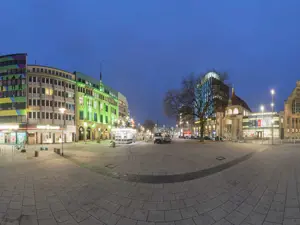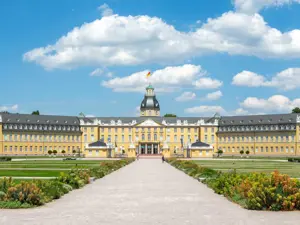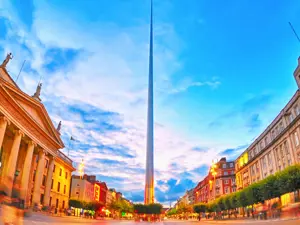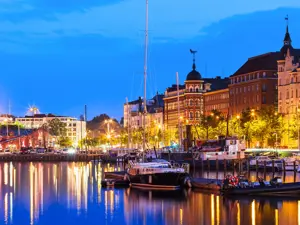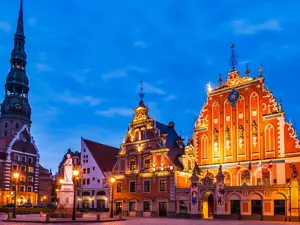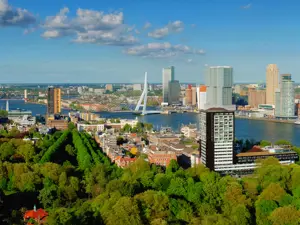City of merchants and scholars
It was called “the Queen of the Hanseatic League” at the time of its flourishing trading activities in the Middle Ages. The League was a confederation of merchants’ guilds that guaranteed privileges for its members, including Lübeck, as well as the monopoly over trading with a large part of northern Europe and the Baltic Sea up until almost the Modern Age. Important traces of this past can be seen in the European Museum of the Hanseatic League, which without doubt merits a visit for the detail with which the work and daily life of the period are described.

Copyright © Sisterscom.com, Shutterstock
Situated in the north of Germany on the lower course of the River Trave, which flows a few kilometres from the city into the Baltic Sea in the Travemünde area, Lübeck appears today as a city of almost magical architecture, with tall spires, prominent roofs and slim bell towers.

The Holstentor Gate. Copyright © Sisterscom.com, Shutterstock
The Holstentor Gate of Lübeck
Holstentor Gate, a symbol of the city and the most photographed monument of Lübeck, is one of Germany’s most famous buildings, which symbolises the work and life of the Medieval merchants. This beautiful building, whose image was also depicted on a two euro coin produced by the German mint in 2006, has two tall tapered towers that are connected together by a building of red bricks, bricks that were the preferred building material of the Baltic Gothic period.
But the city is also remembered for being the birthplace of Thomas Mann, a Nobel prize winner for literature in 1929, who set the first of his famous novels, “Buddenbrook” here. This book tells the story of a family of traders from Lübeck from their economic rise to their collapse. The solemn, but spectacular monument with white facade, Buddenbrook House, was the headquarters of the Mann family’s cereal company and the home of the family. Today Buddenbrook House is open to the public and dedicated to the famous Thomas and his brother Heinrich, also a writer.

The historic centre. Copyright © Sisterscom.com, Shutterstock
Since 1987, the city has been declared a UNESCO World Heritage Site for its monuments and buildings, many of which were rebuilt after the bombing of the last World War.
For lovers of history, Eutin Castle merits a visit. This former residence of the prince-bishops of Lübeck, the castle is today a museum with exhibitions that illustrate life at court over the centuries.
The events of Lübeck
The city also offers many attractions and events at which thousands of visitors from all over the world attend. Among these are the wonderful Christmas markets, held in the courtyards of old aristocratic houses or convents (usually those inside the medieval Holy Spirit Hospital or St. Peter’s Church), or the visit to the sailing vessel Passat, which has crossed Cape Horn almost forty times and has been anchored in Travemünde Port since 1960. In July, in the same port, a week of sailing takes place at which over 3000 yachts take part from more than 20 different countries. A trip on a boat along the former internal German border is also well worth trying.

Trave River. Copyright © Sisterscom.com, Shutterstock
An event not to be missed, in the warm evenings of summer along the Trave River promenade, is the spectacular music festival that offers jazz and classical music performed by various international artists.

Café Niederegger. Copyright © Sisterscom.com, Shutterstock
The marzapane
The factory, headquartered in Lübeck, was established by Georg Niederegger (1777-1856) and is still owned by the Niederegger family. Directly opposite the Town Hall in the heart of the Old Town is the famous Café Niederegger with the marzipan salon where you can discover the history and how this delicacy is made.
It has a room made entirely of marzipan with twelve life-sized figures made of the same sweet confection, where visitors can also receive lessons on how to make marzipan.

Herring in brine. Copyright © Sisterscom.com, Shutterstock
Lübeck’s cuisine
Lübeck’s cuisine dispels the myth of German dishes being only made of sausages and sauerkraut and offers flavoursome recipes, and not just sweets made of marzipan, the traditional food and symbol of the city. Schiffersgesellschaft is a restaurant with a time-honoured atmosphere, with nautical furnishings, and is a city institution. It was formerly the headquarters of the Sailors’ Corporation and offers traditional north German dishes such as stews of venison, wild boar and duck or soups of mussels or salmon and pickled herrings, all washed down with Rotspon, a full-bodied red wine from the local area.
Text by Anna Glik
Updated by Alisè Vitri
Avion Tourism Magazine
Photos: Copyright © Sisterscom.com, Shutterstock
Copyright © Sisterscom.com
Tourist Board
www.luebeck-tourism.de
www.germany.travel
Partnership with Booking.com
Where to sleep in Lübeck

Copyright © Sisterscom.com, Shutterstock
Lübeck is a welcoming city and offers different possibilities for accommodation.
To find the ideal hotel and the best offers you can do a search for the stars but also for districts or landmarks.
DISTRICTS
Hotels in the districts
LANDMARKS
Hotels in tourist areas
WHERE TO GO in Lübeck
Monuments of Lübeck

Copyright © Sisterscom.com, Shutterstock
LUBECK'S CATHEDRAL
Mühlendamm 2-6
It was Henry the Lion who laid the foundations to the cathedral on the southern edge of the Old Town at the Mühlenteich. After the city had became a bishop's see in 1160, construction on the mighty Gothic brickwork began in 1173. The three-naved hall church is one of the oldest monuments in Lübeck. Lübeck Cathedral houses numerous works of art such as the 17 metre high Triumphal Cross by Bernt Notke (1477).
www.domzuluebeck.de
It was Henry the Lion who laid the foundations to the cathedral on the southern edge of the Old Town at the Mühlenteich. After the city had became a bishop's see in 1160, construction on the mighty Gothic brickwork began in 1173. The three-naved hall church is one of the oldest monuments in Lübeck. Lübeck Cathedral houses numerous works of art such as the 17 metre high Triumphal Cross by Bernt Notke (1477).
www.domzuluebeck.de

Copyright © Sisterscom.com, Shutterstock
HOLSTEN GATE
Holstentorplatz
The Holsten Gate is one of the most famous sights in Lübeck. In medieval times, Lübeck was considered to be an important city and owes its thanks to the success of the Lübeck merchants. Holsten Gate became the proud symbol of Lübeck as a free city. The city gate was built between 1464 and 1478 along the lines of Dutch models. Its purpose served both as a form of defence and as a form of prestige. Take a look inside the monument, there are historic ship models, suits of armour, weapons, legal instruments and merchandise. Two majestic lions stand guarding the city in front of the Holsten Gate.
www.museum-holstentor.de
The Holsten Gate is one of the most famous sights in Lübeck. In medieval times, Lübeck was considered to be an important city and owes its thanks to the success of the Lübeck merchants. Holsten Gate became the proud symbol of Lübeck as a free city. The city gate was built between 1464 and 1478 along the lines of Dutch models. Its purpose served both as a form of defence and as a form of prestige. Take a look inside the monument, there are historic ship models, suits of armour, weapons, legal instruments and merchandise. Two majestic lions stand guarding the city in front of the Holsten Gate.
www.museum-holstentor.de

Copyright © Sisterscom.com, Shutterstock
ST. MARY'S CHURCH OF LUBECK
Schüsselbuden 13
St. Mary's Church is the third-largest church in Germany. Numerous works of arts are to be found in St. Mary's interior: The Cross of Triumph by Gerhard Marcks in the high choir above the Swarte Altar from 1495. The commemorative chapel in the south tower with its church bells possesses a unique expressive power.
www.st-marien-luebek.de
St. Mary's Church is the third-largest church in Germany. Numerous works of arts are to be found in St. Mary's interior: The Cross of Triumph by Gerhard Marcks in the high choir above the Swarte Altar from 1495. The commemorative chapel in the south tower with its church bells possesses a unique expressive power.
www.st-marien-luebek.de
Museums of Lübeck

Copyright © Sisterscom.com, Shutterstock
ST. ANNE'S MUSEUM QUARTER
St. Annen-Straße 15
Since the beginning of 2013 visitors of the St. Anne’s museum and St. Anne’s Art Gallery can explore the exhibitions from a totally new perspective on an area of 9.000 sq m. The exhibition offers a deep insight into Lübeck’s history.
www.mq-st-annen.de
Since the beginning of 2013 visitors of the St. Anne’s museum and St. Anne’s Art Gallery can explore the exhibitions from a totally new perspective on an area of 9.000 sq m. The exhibition offers a deep insight into Lübeck’s history.
www.mq-st-annen.de

Copyright © Sisterscom.com, Shutterstock
MUSEUM HARBUR
The Museum Harbour in Lübeck's Old Town exhibit to the visitors the historical traditional sailings vessels. Behind the 100-year-old swing bridge, lies the home port with more than 20 traditional sailing ships. The old sailing ships were acquired and restored by lovers of traditional seafaring and are now berthed at the Harbour against the picturesque backdrop of Lübeck's Old Town.
Excursions in Lübeck

Copyright © Sisterscom.com, Shutterstock
BOAT TRIP ON THE TRAVE RIVER

Copyright © Sisterscom.com, Shutterstock
TRAVEMUENDE ON THE BALTIC SEA
News & Useful info
You might be interested in
Destinations found in the vicinity
Other destinations
Airports nearby Lübeck










